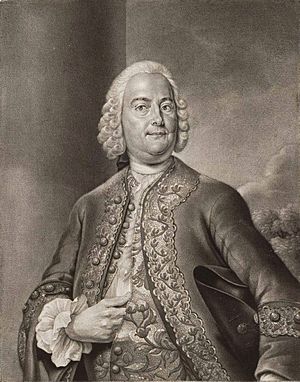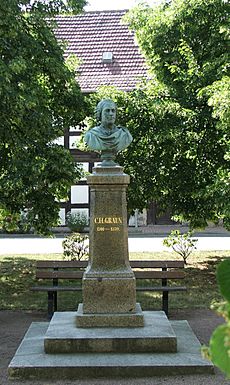Carl Heinrich Graun facts for kids
Quick facts for kids
Carl Heinrich Graun
|
|
|---|---|
 |
|
| Born | 7 May 1704 Wahrenbrück, Electorate of Saxony
|
| Died | 8 August 1759 (aged 55) |
| Nationality | German |
| Education | Kreuzkirche, Dresden |
| Occupation | composer, tenor |
| Years active | 1726–1756 |
| Known for | most important German composer of Italian opera of his time, along with Johann Adolph Hasse |
|
Notable work
|
Kapellmeister to Frederick the Great |
| Spouse(s) | two |
| Children | one daughter, four sons |
| Relatives | Johann Gottlieb Graun (brother) |
Carl Heinrich Graun (born May 7, 1704 – died August 8, 1759) was a German composer and tenor (a male singer). He was one of the most important German composers of Italian opera during his time. People often compare him to Johann Adolph Hasse, another famous composer.
About Carl Heinrich Graun
Carl Heinrich Graun was born in a town called Wahrenbrück in Germany. In 1714, he went to a school in Dresden with his brother, Johann Gottlieb Graun. While there, he sang in the school choir and also in the chorus at the opera house.
He learned how to sing from Christian Petzold. He also studied composition, which is the art of writing music, with Johann Christoph Schmidt.
In 1724, Graun moved to Braunschweig. He continued singing at the opera house there. He also started writing his own music, creating six operas for the company.
In 1735, Graun moved to Rheinsberg. He had written an opera called Lo specchio della fedeltà for a special event. This opera was for the wedding of Prince Frederick in 1733. Prince Frederick later became known as Frederick the Great, a very important king.
When Frederick became king in 1740, he gave Graun a very important job. He made Graun his Kapellmeister. This means Graun was the main music director for the king. He held this important position for nineteen years, until he died in Berlin.
Graun wrote many operas during his career. His opera Cesare e Cleopatra was performed at the grand opening of the Berlin State Opera in 1742. Another famous opera, Montezuma (written in 1755), had its story (called a libretto) written by King Frederick himself!
Even though his operas are not often performed today, one of his special musical works was very popular. This was his passion cantata called Der Tod Jesu (which means The Death of Jesus). It was written in 1755 and was performed frequently in Germany for many years after his death. He also wrote other types of music, like concertos and trio sonatas. People knew him for setting words to music very well, probably because he was also a singer.
Carl Heinrich Graun was married twice. From his first marriage, he had a daughter who also became a singer. From his second marriage, he had four sons.
Main Works
Graun wrote many different kinds of music. Here are some of his most notable works:
Operas
- Polydorus (1726–28)
- Iphigenia in Aulis (1728)
- Lo specchio della fedeltà (1733)
- Cesare e Cleopatra (1742)
- Catone in Utica (1743)
- Alessandro e Poro (1744)
- Adriano in Siria (1746)
- Angelica e Medoro (1749)
- Montezuma (1755)
Other Music
- Te Deum (a Christian hymn)
- Ein Lämmlein geht und trägt die Schuld (a Passion cantata, around 1730)
- Der Tod Jesu (The Death of Jesus), a famous Passion cantata (1755)
- Christmas Oratorio
- Easter Oratorio
- Six Italian Cantatas
- Concertos for instruments like horn, strings, and harpsichord
- Lieder (German songs)
- Sinfonia C major (a type of symphony)
- Gigue in B-flat minor (a lively dance piece)
See also
 In Spanish: Carl Heinrich Graun para niños
In Spanish: Carl Heinrich Graun para niños


